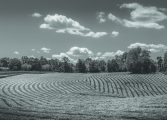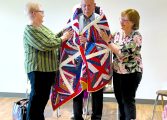“I create atmosphere in a painting with a wet on wet technique, but another option is to limit the palette colors you are using,” he said as he brushed on a large swath of Naples yellow mixed with blue then added ultramarine blue and burnt umber for the background of his snow scene.
One member asked why he constantly wipes his brush; she thought it would reduce the strength of the pigment he was using.
“It depends on the look you are trying to achieve,” he said. “The paper is still wet and I want a softer look.” For stronger pigment color or glazing (building layers of color) the paper has to be dry. Snow admitted he is a deliberate painter and it takes days to complete a finished product.
Therefore, to work faster, he would use a hairdryer to dry the paper.
He began the process of blocking in shapes and colors, sweeping and blending.
“Don’t be afraid to use larger brushes,” he said, adding that smaller detail brushes are limiting and should only be confined to tiny details. Bigger brushes lessen control of the painting experience.
Another member asked why he allows the paint to run into other areas.
“Let the paint work for you; don’t try to control everything,” he said. “I let the paint do its own thing because I’m trying to create a feeling.”
As he painted members began to see a winter landscape emerge from some simple shapes and forms. Members wondered if it was necessary to spend so much time on blocking in the shapes.
“It is time consuming but necessary to delineate the shapes,” Snow said. This is the start of the painting where painters draw in the scene with their brush. Beginners often try to dive right into painting without realizing that drawing is an integral part of all art and cannot be avoided. He advised them to draw and practice drawing.
He suggested that artists give themselves time to paint.
“Time yourself, give yourself an hour or two and work over the entire painting, not just a corner. One of the biggest mistakes beginning artists do is work on one small area of the painting instead of the entire scene.” For beginners he recommended taking a piece of paper and dividing it into quarters, then using a large brush and two colors, work in shapes, shadows and practice until they feel comfortable.
He then added shadows to define dimension and depth. Some questioned why he was going from lights to darks since in some forms of painting lights are added last. In watercolor, leaving the pure white of the paper is an essential rule to the purist, and that can only be achieved by leaving areas of the paper white, so other areas are built up with pigments and become darker.
“There are different ways to approach watercolor but most will tell you to work light to dark,” he said. “Often with watercolor many struggle with lights and darks. It’s not what you put in but what you don’t put in.” He suggested looking at the watercolors done by John Singer Sargent. “Also, don’t over mix the paint; you can end up with a lot of darks. Don’t be afraid of pure color.”
A member asked about his background as a graphic artist and what he thought about the computer versus hands-on techniques in art nowadays.
“They are just different tools. Applications like Photoshop are limited in their appearance of mediums, including watercolor,” he said. But he did not knock the computer, adding that he has seen some amazing graphic artist work done on computers. “Illustrators of the past like Norman Rockwell and N.C. Wyeth are not extinct but have shifted to fine art,” he said
Since the painting was far from done, Snow explained what his usual next step would be in its completion. He also told the members to begin with soft and light shapes and define the edges later.
“There are no hard and fast rules, but these are the best ways to work in watercolor,” Snow said.




